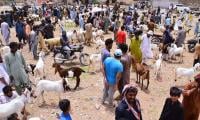LAHORE: The Lahore Woven Garments Consortium, a collaborative entity of eight small garment exporters, has surprisingly multiplied their combined exports by five times in just 16 years through mutual cooperation in purchases, marketing, hiring, and equipment upgrade.
Incredibly, this growth is 2.5 times higher than what national exports could manage and it clearly shows anything is possible if you really want to make it happen.
This way, the members of the group, have not only flourished but also saved themselves from extinction like hundreds of similar businesses that folded up in two decades of economic turbulence both due to local policies and global ups and downs.
This collaboration is in vogue in many economies particularly India but it was one of the rarest in Pakistan.
The fact that the consortium has survived for so long is a tribute to the accommodative nature of the group members.
These innovative business partners, who have maintained their individual entities in over one and a half decade, recently shared their experience at an event held at Lahore University of Management Sciences’ Suleman Dawood School of Business.
“This consortium was formed after the 9/11 when the going was getting tougher for Pakistani exporters particularly those, who were beginning to explore foreign markets” said Jawad Chaudhry a member of the consortium.
Chaudhry said besides scarcity of orders, small exporters were handicapped by the high input costs compared with what was available to large exporters.
He said it was natural that the larger ones enjoyed the benefit of economies of scale and were granted more discount by the input providers. “Initially our consortium comprised 21 members and we placed a single order to buy common inputs in order to get the best deal,” he added.
He said this effort benefited most of the exporters and within a few years members started leaving the group because of various reasons.
Hamid Saleem, a consortium member, revealed that when the consortium was formed Pakistan’s exports were $10 billion per year while the cumulative exports of our members were only $25 million.
“Now our exports are 21 billion, while exports of our members have crossed $125 million,” Saleem said.
He added that more specifically the apparel export of Pakistan stood at $4 billion and after the formation of the consortium these exports have now reached $4.8 billion.
“From that point of view, increase in the share of consortium members’ exports is about 16 times more than the overall increase in apparel exports,” the exporter said.
Explaining the reason for so many defections, Iqbal Bhatti, a member, said some graduated to a higher level while others lacked trust in the consortium.
“It took us five years to build full confidence in each other and dueing that period our only activity was confined to joint buying of inputs,” Bhatti said and added that gradually the surviving members magnified the scope of cooperation. “We started sharing information about our export markets. This was due to the confidence that none of the member will encroach upon the foreign buyer of the other.”
He said the garment market was very large and members were able to find new buyers that were not catered by others.
“The joint marketing, however, did not succeed and now we invite foreign buyers in Lahore and facilitate them to visit all our members,” Bhatti added.
He further said the foreign buyers were in the habit of quoting prices even lower than the cost from one supplier to the other. “This does not work in our group as we know the cost and quote prices with reasonable profit,” he said.
Sajid saleem Minhas, a consortium member, said the collaboration has reached a higher level.
“Now we collaborate with each other in the upgrade of equipment. Instead of placing orders separately those of us wanting to upgrade make a collective deal that saves cost,” Minhas said.
He added that the members also share their bad experiences of some equipment so that the other member does not get trapped into buying a defective technology. “We also do not poach on each other’s human resource and in many cases train each other’s workforce in one of our factories,” Minhas said.
The group said the next step was mergers and acquisition, which was a little tougher a task as no one in Pakistan was ready to lose their identity.
“Efforts are afoot in this regard because real economies of scales could be achieved through full mergers. Moreover the newly merged entity would have multiple foreign buyers in hand,” a member said.
The headquarters of the Sui Southern Gas Company . — APP FileKARACHI: Sui Southern Gas Company has launched a fresh...
The logo of the ExpoMed Eurasia. — CA MI websiteKARACHI: Pakistan is participating in ExpoMed Eurasia, a leading...
Gold bars are seen in this undated file photo. — AFP/FileKARACHI: Gold prices increased by Rs500 per tola on...
FFBL Head Office building can be seen in Islamabad. — FFBL WebsiteKARACHI: Fauji Fertilizer Bin Qasim Limited has...
Representational file of an BMW car. — AFP FileLAHORE: Small improvements in economic credentials of the country are...
A fuel station worker filling petrol in vehicle at a fuel station in Karachi on Tuesday, April 16, 2024KARACHI: After...







